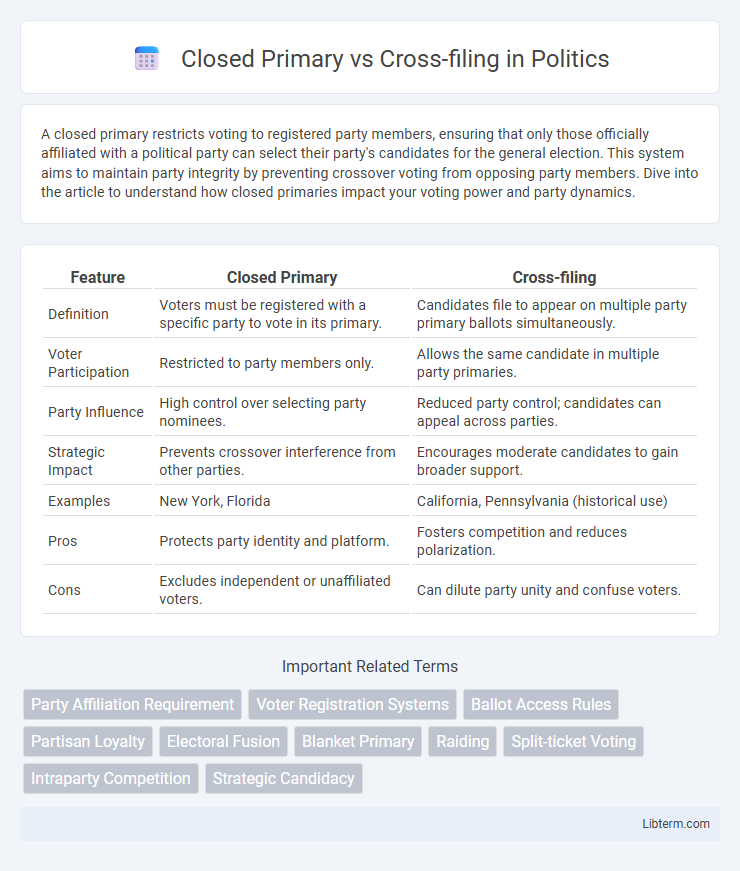A closed primary restricts voting to registered party members, ensuring that only those officially affiliated with a political party can select their party's candidates for the general election. This system aims to maintain party integrity by preventing crossover voting from opposing party members. Dive into the article to understand how closed primaries impact your voting power and party dynamics.
Table of Comparison
| Feature | Closed Primary | Cross-filing |
|---|---|---|
| Definition | Voters must be registered with a specific party to vote in its primary. | Candidates file to appear on multiple party primary ballots simultaneously. |
| Voter Participation | Restricted to party members only. | Allows the same candidate in multiple party primaries. |
| Party Influence | High control over selecting party nominees. | Reduced party control; candidates can appeal across parties. |
| Strategic Impact | Prevents crossover interference from other parties. | Encourages moderate candidates to gain broader support. |
| Examples | New York, Florida | California, Pennsylvania (historical use) |
| Pros | Protects party identity and platform. | Fosters competition and reduces polarization. |
| Cons | Excludes independent or unaffiliated voters. | Can dilute party unity and confuse voters. |
Understanding Closed Primaries
Closed primaries restrict voting to registered party members, ensuring that only Democrats vote in Democratic primaries and Republicans in Republican primaries, which preserves the party's control over candidate selection. This system reduces the risk of crossover voting, where members of one party might influence the opposing party's nominee, thus maintaining ideological consistency within parties. Closed primaries often lead to higher party loyalty and clearer voter alignment with party platforms during general elections.
What is Cross-filing?
Cross-filing is an electoral practice allowing candidates to run in multiple party primaries simultaneously, typically in nonpartisan or judicial elections, to increase their chances of appearing on the ballot. This contrasts with closed primaries, where voters must choose candidates only from their registered party, preventing cross-party candidacies. Cross-filing can lead to a candidate securing nominations from multiple parties, potentially running unopposed in general elections.
Historical Background of Primary Elections
Primary elections emerged in the early 20th century as a reform to increase democratic participation and reduce political machines' influence on candidate selection. Closed primaries restrict voting to registered party members, a practice rooted in efforts to strengthen party loyalty and prevent crossover voting, which gained prominence during the Progressive Era. Cross-filing, introduced in states like California during the 20th century, allowed candidates to run in multiple party primaries simultaneously, reflecting attempts to diminish partisan control and foster broader electoral competition.
Key Differences Between Closed Primaries and Cross-filing
Closed primaries restrict voting to registered party members, ensuring candidates are selected by a party's own base, whereas cross-filing allows candidates to appear on multiple party ballots, enabling them to seek nominations from more than one party simultaneously. Voter eligibility in closed primaries is strictly limited by party affiliation, while cross-filing opens broader access for candidates to compete across party lines. The impact on political strategy is significant: closed primaries tend to reinforce party loyalty, whereas cross-filing can promote moderate candidates by appealing to multiple party electorates.
Advantages of Closed Primaries
Closed primaries restrict voting to registered party members, ensuring candidates represent the true preferences of their party base, which strengthens party unity and ideological consistency. This system reduces the risk of strategic voting by opposition members, protecting the integrity of candidate selection and minimizing crossover interference. By limiting participation, closed primaries encourage greater party loyalty and more accurate reflection of party values in the general election.
Pros and Cons of Cross-filing
Cross-filing allows candidates to run in multiple party primaries simultaneously, increasing their chances of securing a nomination in states with open filing rules. This practice can dilute party loyalty and create confusion among voters by blurring ideological distinctions between candidates. However, cross-filing also promotes broader appeal and can lead to more moderate, consensus-driven campaigns, reducing partisan polarization.
Impact on Voter Participation
Closed primaries restrict voting to registered party members, often leading to lower voter participation by excluding independents and unaffiliated voters. Cross-filing allows candidates to run on multiple party ballots, potentially increasing voter engagement by broadening candidate choices and encouraging participation from a wider electorate. The increased inclusivity of cross-filing systems tends to boost turnout compared to the exclusivity of closed primaries.
Effects on Political Parties and Candidates
Closed primaries restrict voting to registered party members, reinforcing party cohesion and limiting candidate competition to within the party, which often strengthens party loyalty and ideological consistency. Cross-filing allows candidates to run in multiple party primaries simultaneously, potentially diluting party identity and enabling moderate or non-traditional candidates to appeal across party lines. This practice can undermine party control over nominations and blur ideological distinctions, impacting party strategy and candidate positioning in general elections.
State Examples and Legal Frameworks
Closed primaries require voters to register with a specific party to participate, as seen in states like New York and Florida, where electoral laws strictly enforce party affiliation for ballot access. In contrast, cross-filing allows candidates to run in multiple party primaries simultaneously, a practice historically notable in California and Pennsylvania, governed by unique statutory provisions permitting such filings. Legal frameworks vary significantly, with closed primary states emphasizing party loyalty and voter registration laws, while cross-filing systems rely on statutes enabling broader candidate participation across party lines.
Future Trends in Primary Election Systems
Future trends in primary election systems highlight a growing interest in hybrid models combining elements of closed primaries and cross-filing to enhance voter choice and party representation. Data indicates increasing adoption of cross-filing in states aiming to reduce partisan polarization by allowing candidates to appear on multiple party ballots. Advances in voter data analytics also drive innovations toward more inclusive, yet strategically structured, primary formats that balance party influence with broader voter participation.
Closed Primary Infographic

 libterm.com
libterm.com